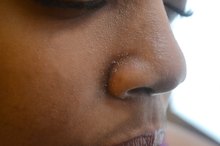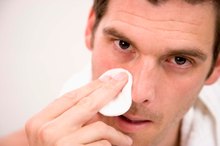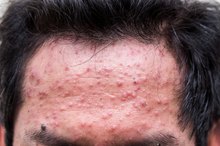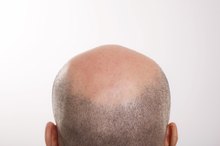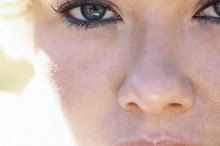Red, Dry Skin on the Nose
Your nose is the focal point on your face and the one of the first things people see. So when it's blemished, facing the world can be intimidating. Red, dry skin on the nose can take a toll on your confidence. There are various reasons and treatments for your condition, and some can be more serious than others and may require a visit to your doctor.
Wind and Sun Exposure
Given the location and always-exposed nature of of your nose, it’s naturally unprotected from elements such as sun and cold weather. Both can strip the moisture out of skin, leaving it dry and irritated. In the cold months, try using a heavy moisturizer to prevent dry chapped skin -- especially on the sides of the nose, where dry skin can be most problematic. Protect skin by wearing sunscreen and a hat in the warmer months. Both will lessen the chances of your nose becoming sunburned.
- Given the location and always-exposed nature of of your nose, it’s naturally unprotected from elements such as sun and cold weather.
- In the cold months, try using a heavy moisturizer to prevent dry chapped skin -- especially on the sides of the nose, where dry skin can be most problematic.
Skin Cancer
Causes of a Red Nose
Learn More
Prevention of skin cancer is another good reason to protect your nose against the sun 1. According to the Skin Cancer Foundation, two million new skin cancer cases are diagnosed yearly 1. Actinic keratoses usually start as a dry red or brown patches and can lead to developing squamous cell carcinoma. They are both primarily found in areas that have had excessive sun exposure, such as your nose, face, ears and hands. If your dry red patches get larger, see a doctor.
- Prevention of skin cancer is another good reason to protect your nose against the sun 1.
- Actinic keratoses usually start as a dry red or brown patches and can lead to developing squamous cell carcinoma.
Rosacea
Rosacea is another potential cause of dry red skin on your nose. It’s an inflammatory disease that causes such symptoms and usually is seen on the face. Acne rosacea is another form of this disease causing facial skin to become red and dry 2. It can also cause pores to become infected and cause acne breakouts and scaring. Rhinophyma is a type of rosacea in which the nose actually becomes enlarged, red and dry. Treatment varies depending on type and severity from prescription cream to antibiotics.
- Rosacea is another potential cause of dry red skin on your nose.
- Acne rosacea is another form of this disease causing facial skin to become red and dry 2.
Eczema
How to Get Rid of Dry Skin on My Nose
Learn More
Seborrheic dermatitis is a type of eczema. While there are many forms of this condition, seborrheic dermatitis is the type most commonly found on the nose. It causes dry, red patches to form on the nose, eyebrows, ears and scalp. It can become cause itchiness and infection. There are many low-dose, over-the-counter treatment options, such as creams. More severe cases may require a higher dose and a prescription from your doctor.
- Seborrheic dermatitis is a type of eczema.
- While there are many forms of this condition, seborrheic dermatitis is the type most commonly found on the nose.
Psoriasis
Psoriasis is an autoimmune disease in which your body produces too many skin cells, causing red, scaly patches. There are several types of psoriasis, but 80 percent of psoriasis sufferers only suffer from plaque or skin cell buildup -- as opposed to blistering of the skin. Plaque psoriasis can be found all over the body, but is most common on the sides of nose, face, hands, elbows and knees. Like eczema, there are both over-the-counter treatments and prescription options that range from creams to UV light therapy from your doctor.
- Psoriasis is an autoimmune disease in which your body produces too many skin cells, causing red, scaly patches.
- There are several types of psoriasis, but 80 percent of psoriasis sufferers only suffer from plaque or skin cell buildup -- as opposed to blistering of the skin.
Related Articles
References
- Skin Cancer Foundation: Skin Cancer
- Cleveland Clinic: Acne and Rosacea
- National Eczema Association
- National Psoriasis Foundation: Psoriasis
- American Academy of Dermatology. Rosacea. Published 2017.
- American Academy of Dermatology. Rosacea: signs and symptoms.
- Laun J, Gopman J, Elston JB, Harrington MA. Rhinophyma. Eplasty. 2015;15:ic25.
- American Academy of Dermatology. Triggers could be causing your rosacea flare-ups.
- American Academy of Dermatology. Rosacea treatments: acne-like breakouts.
- American Academy of Dermatology. Psoriasis: causes.
- Centers for Disease Control and Prevention. Psoriasis. Updated October 25, 2018.
- American Academy of Dermatology. Medication and lights.
- American Academy of Dermatology. Atopic dermatitis: diagnosis and treatment.
- Friedman BC, Goldman RD. Anti-staphylococcal treatment in dermatitis. Can Fam Physician. 2011;57(6):669-71.
- American Academy of Dermatology. Triggers.
- Hajar T, Gontijo JRV, Hanifin JM. New and developing therapies for atopic dermatitis. An Bras Dermatol. 2018;93(1):104-107. doi:10.1590/abd1806-4841.20187682
- American Academy of Dermatology. Rosacea treatment: eye problems.
Writer Bio
Jeff Herman began his journalism career in 2000. An experienced, award-winning sportswriter, his work has appeared in "The Washington Post," "ESPN the Magazine" and the "Boston Herald," among other publications. Herman has a Bachelor of Arts in journalism from West Virginia University.

